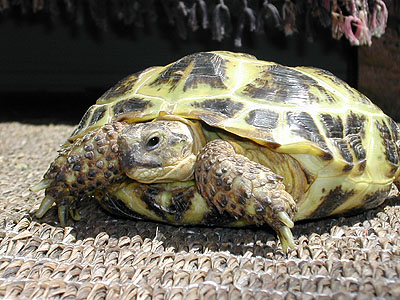In celebration of World Turtle Day, not only do I want to recognize our very own Russian tortoise Buster, who’ve I’ve been guardian of since 2001:

But I also want to recognize and reflect on what is without a doubt to me the most important and influential — however metaphorical — chelonian I’ve ever encountered, namely the “land turtle” John Steinbeck brought me to in his The Grapes of Wrath.
I did crazy shit in my early/mid teens, like read books for pleasure. I credit my seventh grade English teaching team of Ms. Latzke and Ms. Diamond at Le Conte Junior High with getting that going. Sure, I raced through all six of C.S. Lewis’ Narnian chronicles in sixth grade, but it was Latzke/Diamond’s assignment to read Richard Adams’ Watership Down in 1977 that got me fired up about reading, big time. It remains my favorite book of all time.
So, while other kids in the years bookending 1980 could be found honing their marginal skateboard skills or getting recreational with drugs or trying to figure out how to get their parents to buy them radios with the then-unexplored and mysterious FM radio dials, I could often be found inside with KHJ or The Mighty 690 or KGIL on the Admiral Hi-Fi… reading. And not just Hardy Boys mysteries or the terrifying stuff from the frightening mind of Stephen King, but shit like Ira Levin’s Rosemary’s Baby and Ayn Rand’s The Fountainhead and Truman Capote’s In Cold Blood. For fun in 9th grade I read Frederick Forsyth’s Day of the Jackal. In one day. A Saturday. In the summer.
What a nut I was. But if I can request a digression: that’s nothing. A few years earlier after seeing Jaws in the old Wilshire Theater in Beverly Hillls (having already read the book, of course) I decided to face my suddenly all-encompassing fear of the killer fish — I’m telling you I was sure one was going to come up through the shower drain and eat me —by going down to the Hollywood branch of the library, checking out a whole bunch of material on sharks, and not just reading about them — but writing a freakin’ report to myself on the topic.
I can’t recall exactly how I got introduced to Steinbeck, but if my memory isn’t playing with me I viisualize myself reading it in the duplex apartment we lived in on Wilton Place a few blocks north of Beverly Boulevard, which means it would be ’78-’79. It was my mom’s copy of the book and I think the catalyst that drove me to pick it up was learning that my favorite actor at the time, Henry Fonda, had starred in the movie version, which I hadn’t yet seen. Opening the book up I was immediately drawn into it — not so much because it mythically grabs you and doesn’t let go… moreso because of Steinbeck’s wholly accessible writing style and the visuals he seemed to so effortlessly create.
Through the first chapter I went, disbelieving the unfathomable desperate dusty dryness of Oklahoma that Steinbeck was showing me. I could almost feel it caking my skin and powdering my nose. In the second chapter he put me in a truck with its nosy driver and a homeward bound Tom Joad fresh out of prison for murder and I knew immediately Tom’s who Fonda must’ve played in the film.
Turning the page to chapter three I was like the driver and very curious to learn more about Tom myself, but Steinbeck had other plans. Instead he decides Joad’s been intruded upon enough and for the time being he says come over here away from Tom for a bit and let me show you this tortoise here along the side of the road. And at first my entirely unsophisticated 15-year-old intellect balks hard at this strange interruption. I don’t care about some critter crawling around in the dirt out in the middle of nowhere, I wanna know what’s going on with Tom! But Steinbeck puts a hand on my shoulder and points to the tortoise and says we’ll get back to Tom in a few minutes but right now this is important, right now take a closer look.
And so I do.
And three pages later I want to be a writer when I grow up. Three harrowing pages later at the chapter’s end I’m riveted to the old fella dragging itself and its shell along through the dust on the other side of the asphalt and I got it. I may not have known it was called a metaphor or even how to spell the word at that stage in my life, but instinctively I knew what Steinbeck had done. At first literal glance he was showing me why the tortoise crossed the road. But far deeper down he had shown me an unforgettable symbol of the struggle to persevere in an unforgiving environment, of resolutely overcoming obstacles amid tremendous adversity. Of surviving.
So on this World Turtle Day I give thanks and respect and love to the tortoise I’m personally responsible for, to all turtles the world over, and especially to that resolute and persistent one from Steinbeck’s imagination and talent.
 Follow
Follow